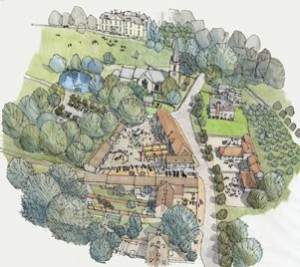Bid to bring Stanmer Park’s 18th century landscape to a 21st century audience
November 7, 2014
 Brighton & Hove’s largest public open space, Stanmer Park in the South Downs National Park, is the focus of a heritage project to restore the Grade II listed estate and safeguard one of the country’s rarest landscapes for future generations.
Brighton & Hove’s largest public open space, Stanmer Park in the South Downs National Park, is the focus of a heritage project to restore the Grade II listed estate and safeguard one of the country’s rarest landscapes for future generations.
Brighton & Hove City Council, along with the South Downs National Park Authority, have submitted a Heritage Grant bid of £5.9 million to the Heritage Lottery Fund to restore Stanmer’s historic farm buildings and bring them back into use.
The council is leading on plans for the Stanmer Park and Estate Restoration Project. The aim is to restore the park’s landscape and buildings, protect natural features and encourage wildlife.
At the heart of the estate lie 18 buildings that make up Home Farm – including cattle shelters, a dovecote dating back to 1615, a dairy and a Grade 2 Sussex Long Barn. Together they tell the story of farming in this part of the South Downs over the past 250 years. The farm is currently closed to the public because the buildings are in urgent need of restoration.
Stanmer Park lies within the South Downs National Park and has the potential to be an important gateway encouraging people from Brighton and Hove to explore and appreciate their local countryside. Plans include a new visitor centre and a base for the South Downs National Park Authority’s local ranger team.
Councillor Pete West, chair of the city’s environment committee, said: “This is a much loved and nationally significant park; a rare survival of an original 18th century landscape still in public ownership that we want to preserve for future generations. It feels like you are in the heart of the countryside, yet Stanmer is less than five kilometres from the city centre.
“There are 27 listed buildings in this park, from the big house to the village cottages. Our vision is to bring the historic farmstead back to life as a visitor centre from which to explore the rest of the estate. Stanmer Park has the potential to become one of the greatest attractions in the city.”
Trevor Beattie, Chief Executive for the South Downs National Park Authority, said:
“Stanmer Park and Estate are a unique survival – a living record of farming and social history going all the way back to the Domesday Book. This bid recognises the national significance of Stanmer by planning to restore it to its former glory as a major new gateway to the South Downs National Park.”
Stanmer Park – Facts and figures
- At 485 hectares, Stanmer Park accounts for a third of all the parks and gardens space in Brighton and Hove.
- Around half a million people visit Stanmer Park every year, and that could rise to 800,000 following the restoration work.
- Records of a settlement at Stanmer date back to Saxon times, During the 18th century an estate was created for the Pelham family, with Stanmer House, built in 1722, at the centre. The park landscape was developed in the style of Capability Brown.
- The farmstead has 18 agricultural buildings dating from the 18th and 19th centuries and there is an 18th century walled garden to the west of the village.
- During the Second World War Stanmer Park was used to provide billeting and firing ranges for a Canadian regiment. In 1947 Brighton Corporation bought the estate and opened the park to the public in 1953.
- Once the farm buildings are restored, there would be the potential to grow and produce food on site, and there are also plans to restore the walled kitchen garden and nursery. A separate bid of £6 million was submitted to the ‘Parks for People’ fund in the summer to carry out improvements and restorations in the rest of the park.
- The bids include input from local organisations, residents and park visitors. More than 2,500 people took part in the two-year consultation.
Restoration work will provide apprenticeship opportunities for around 100 people, training for volunteers and space for Plumpton Agricultural College to train students. - If approved, the funding would be spent in a five year investment programme estimated at £11.9 million, starting with drawing up detailed designs with the help of the public and partners. Development work would begin in February which is when the outcome of the bid is expected.
